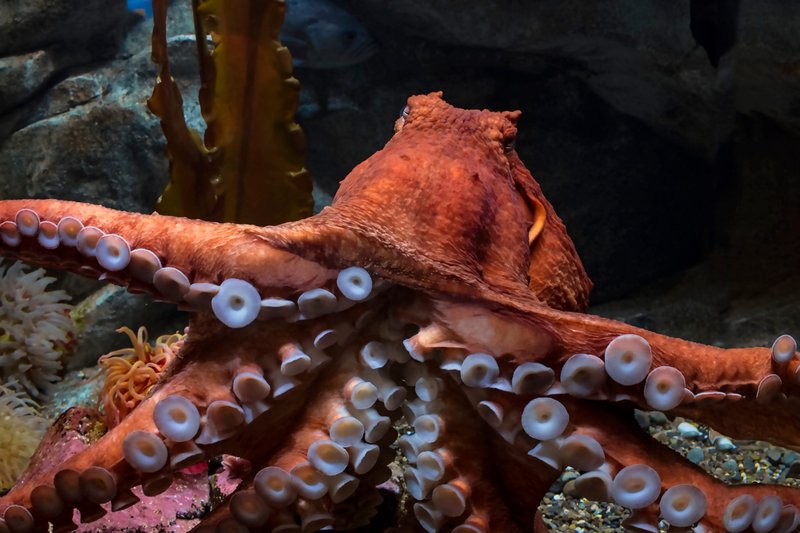
The main issues they deal with come from both humans and nature. From climate change affecting their habitats to overfishing in their waters, it’s a rough world for these clever cephalopods. Let’s dive deeper into where they stand in terms of conservation, exploring recent updates and what we can do to help keep them thriving.
Understanding the Status of Giant Pacific Octopuses
To grasp whether the Giant Pacific octopus is endangered, we first need to look at its conservation status. According to the International Union for Conservation of Nature (IUCN), these octopuses are currently listed as ‘Least Concern.’ This sounds great, right? But it’s not the whole story. While they’re not critically endangered, it doesn’t mean they’re safe from threats lurking in the deep blue.
Population Trends: The numbers fluctuate. In some areas, they thrive; in others, they’re struggling. Overfishing is a significant concern, and in certain regions, their population has declined due to excessive harvesting. So, while they aren’t globally recognized as endangered yet, specific local populations may be at risk.
The Habitat of the Giant Pacific Octopus
Giant Pacific octopuses call the Pacific Ocean home, especially along the coasts of the U.S. and Canada. They prefer rocky environments and shallow waters where they can easily hide from predators. Think of it like searching for a cozy spot in a bustling city—you want to blend in while keeping a lookout.
However, habitat destruction is a looming threat. Coastal development and pollution can damage their homes. When their living spaces shrink, it not only affects their survival but also their ability to reproduce effectively. Without a safe place to lay eggs, their future is uncertain.
Threats Facing the Giant Pacific Octopus
Understanding the challenges these octopuses face can help us inform better conservation efforts. Here are some of the main threats:
- Overfishing: As demand for octopus increases, unsustainable fishing practices can lead to population decline.
- Climate Change: Rising sea temperatures affect their food sources and habitat.
- Pollution: Chemical runoff and plastic waste can harm their environments, leading to illness or death.
Each point represents a ripple effect in the ocean ecosystem. For instance, when overfishing happens, not only do we lose octopus but also the balance of their prey and predators. This complexity can be hard to wrap your head around, but it’s crucial to recognize how interconnected everything is.
Biological and Ecological Importance
The role of the Giant Pacific octopus in the ecosystem is vital. They’re not just fascinating to watch; they help control the populations of various marine species. By preying on fish and crustaceans, they maintain a healthy balance in the ocean. Losing them could mean unchecked populations of their prey, leading to unforeseen consequences.
Honestly, even if they’re not currently endangered, their ecological importance should make them a priority for conservation efforts. Protecting them is, in many ways, protecting the ocean’s health.
Conservation Efforts for Giant Pacific Octopuses
Amid the challenges, there are various conservation initiatives aimed at protecting the Giant Pacific octopus. Here’s what’s happening:
- Research Projects: Scientists are actively studying octopus populations to better understand their behavior, reproduction, and habitats.
- Marine Protected Areas: Designated regions in the ocean are established to create safe havens for marine life, including the Giant Pacific octopus.
- Public Awareness Campaigns: Organizations are educating the public about the importance of sustainable fishing and pollution prevention.
By adhering to sustainable practices and supporting these initiatives, we can help ensure the future of this incredible species. Being aware of their plight is the first step towards making a difference.
How You Can Help
You might be wondering, “What can I do to help?” Here are some easy, impactful steps you can take:
- Support Sustainable Seafood: Choose seafood that is caught sustainably, which helps reduce overfishing.
- Reduce Plastic Use: Minimizing plastic consumption can help lower pollution levels in oceans.
- Get Involved Locally: Participate in or support local clean-up efforts to keep marine environments safe.
Every small action can add up to a big impact. By making conscious choices, we can contribute to a healthier ocean and, in turn, a thriving population of Giant Pacific octopuses.
The Future of the Giant Pacific Octopus
So, what’s next for the Giant Pacific octopus? The truth is, their future is still being written. By staying informed and engaging in conservation practices, we can influence how the story unfolds. Current research and public interest are crucial for shaping effective policies that can make a real difference.
Moreover, it’s important to keep a watchful eye on populations that seem to be in decline. Protecting even the least endangered species is fundamental to maintaining the overall health of our planet. Remember, a thriving ecosystem benefits all its inhabitants, including us!
Stay Tuned for Updates
As we learn more about the challenges facing the Giant Pacific octopus, it’s essential to stay updated on conservation efforts and progress. Follow organizations dedicated to marine life, subscribe to newsletters, or join community groups focused on ocean health. It’s time we all become advocates for this magnificent creature and others like it.
In conclusion, while the Giant Pacific octopus may not be officially classified as endangered, that doesn’t mean we can afford to be complacent. The ocean is a shared resource, and it’s on all of us to ensure it remains a vibrant habitat for generations to come. Let’s work together to champion the cause of the Giant Pacific octopus and keep our oceans thriving!

